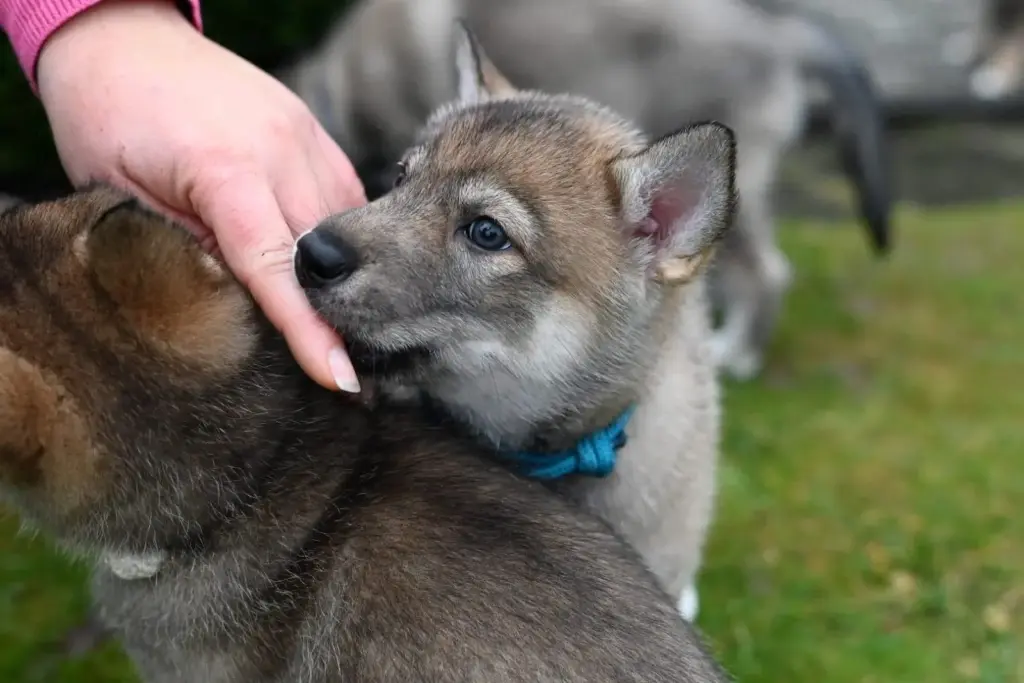I’m delighted that my last blog article was so well received and generated some interesting questions. I was particularly pleased that the topic of epigenetics aroused so much interest. This fascinating branch of research not only inspires scientists worldwide, but also raises new questions in dog breeding and opens up interesting possibilities.
For some time now, I have been so fascinated by epigenetics that I have been studying it intensively.
It is astonishing that epigenetics is still ridiculed by some breeders, even though there are a growing number of studies that emphasise its importance in dog breeding – and especially in wolfdog breeding. Experts in dog behaviour and dog breeding are now even going so far as to call for not only the nature of the dogs to be examined, but above all the character and the breeders‘ willingness to take responsibility. Biologist and science journalist Dr Peter Spork put it succinctly: ‘We should actually be examining the character of the breeders and not the nature of the dogs.’
With this article I would like to show you what epigenetics is, why it is so important and how we can use this knowledge to further develop the breeding of healthy, balanced dogs. Let’s take a deeper look into this exciting world together!

What are epigenetics?
First of all: epigenetics has nothing to do with epilepsy, even if it sounds similar. The term is made up of the words ‘genetics’ and ‘epigenesis’ (the development of a living organism). Epigenetics describes how environmental factors and life circumstances influence the activity of our genes without changing the actual DNA sequence.
In other words, epigenetics is the switch that determines whether a gene is ‘on’ or ‘off’. Influences such as diet, stress, pollutants or the social environment can flip this switch. What is exciting is that these changes not only affect the individual, but can also be passed on to the next generation – a revolutionary approach that is changing our view of heredity and breeding.
Mechanisms of epigenetics
Epigenetics works with three main mechanisms:
1. DNA-methylation
Small molecules, so-called methyl groups, are attached to the DNA. They block certain genes by preventing them from being read. The affected gene remains silenced until the methyl groups are removed.
DNA methylation is the most important epigenetic modification.
2. Histone modifications
Our DNA is wrapped around proteins called histones. Chemical changes to these histones can cause the DNA to be packed tighter or looser. This structure determines whether genes can be read more easily or not.
These mechanisms create a flexible level of control that makes it possible to adapt to environmental changes – an evolutionary advantage that is also being investigated in research on anti-ageing, cancer and stress management in humans.
3. Micro-RNAs
MicroRNAs are small RNA molecules that regulate genes by preventing the translation of RNA into proteins or by causing the degradation of RNA. They play a crucial role in controlling gene activity in nerve cells and influence behaviour and responses to environmental stimuli. Recent studies have shown that certain microRNAs, such as miR135 and miR19b, act as ‘endogenous antidepressants’ or can improve stress management.

Epigenetics in the animal world:
What we can learn from other species
Epigenetics is not a purely human phenomenon. Epigenetic mechanisms also play a central role in animals. For example, a study on mice has shown that the diet of mother animals can influence the coat colour and health of their offspring. Mice whose mothers were fed a methyl-rich diet (e.g. folic acid) showed less susceptibility to disease and a darker agouti. However, mice whose mothers were fed a ‘normal diet’ were more likely to be yellow and significantly more susceptible to cancer, diabetes and obesity. However, with the right diet, ‘yellow’ mothers also gave birth to darker, healthier offspring.

Another example: In a groundbreaking study with bees, it was found that epigenetic regulation determines the development of larvae into workers or queens. Although all larvae have identical DNA, the specific diet (royal jelly) determines which genes are active – and therefore whether the larva becomes a queen.
What does that mean for dog breeding?
Epigenetics is also highly relevant in dog breeding. Dogs may have the same genetic blueprint, but their genes can be ‘switched on’ differently – depending on their environment and upbringing.
Influence of the dam
The role of the dam cannot be emphasised enough. Scientists have discovered that the stress level of the mother during pregnancy can cause epigenetic changes in the puppies. A stressed bitch produces more stress hormones, such as cortisol, which are transmitted to the puppies via the placenta. These hormones can set epigenetic markers in the puppies, which influence the activation or deactivation of certain genes. This determines how stress-resistant or anxious the puppies will be later on.
In addition, the mother’s prenatal stress influences the development of the puppies‘ nervous system. It has been proven that the foetus and the bitch are connected through the bloodstream. This connection also ensures that the puppies are linked to the bitch’s hormonal system. This can lead to the effect of fetal programming.
Fetal programming
If the dam experiences severe stress during pregnancy, the cortisol concentration increases in both her and the unborn puppy. In order to inhibit the release of cortisol above a certain level, there are a certain number of glucocorticoid receptors (GR) that become active when the concentration of cortisol has reached a level above the norm. These receptors then inhibit further production and thus enable the cortisol level to fall again. However, a persistently high prenatal cortisol level causes the body to perceive a higher concentration of cortisol as normal and the number of GR is reduced accordingly – the norm is adjusted upwards! Accordingly, puppies that have been exposed to such foetal programming also secrete significantly more cortisol after birth and also need significantly longer to reduce it again. Studies show that these puppies often show an increased and prolonged response to stressful stimuli and may have difficulty adapting to new or challenging situations. Interestingly, aftercare by the mother dog also has a major influence. A caring and stress-free mother can partially minimise these epigenetic changes, as her attention has a positive influence on the puppies‘ stress processing.
This correlation emphasises the importance of a low-stress environment during pregnancy and early puppy development.

Growing conditions of the puppies
The first few weeks of a puppy’s life are crucial for its later development. This sensitive phase not only shapes basic social and emotional skills, but also sets epigenetic markers that have far-reaching effects on the dog’s behaviour and health. A puppy that grows up in a loving, stress-free environment develops different epigenetic markers than a puppy that grows up in a chaotic or even neglectful environment.
The quality of the interactions between the puppy and its environment plays a central role in this. Positive experiences, such as gentle physical contact, playful interactions and a stable daily routine, promote the release of feel-good hormones such as oxytocin. These hormones not only have a calming effect, but also influence gene expression in regions of the brain that are important for coping with stress and social bonding.
Conversely, negative experiences, such as a lack of care or repeated stress, can set epigenetic markers that increase susceptibility to anxious behaviour or stress reactions. In the long term, such markers can also impair the ability to adapt to new situations, which can manifest itself in insecurity or even behavioural problems.
It is therefore very important to provide puppies with a safe and nurturing environment in the first few weeks of their lives. This foundation not only has a positive effect on the dog’s behaviour, but also supports its health and quality of life in the long term.

Dogs of unknown origin and epigenetics
Particularly in the breeding of mixed breeds, dogs whose pedigree are not very well known are used time and again. A lack of information about origin, rearing and parents is often accepted because, as a consequence, no negative aspects are known. But this is precisely where epigenetics plays a very underestimated role. Dogs without a known pedigree could have epigenetic markers from stressful living conditions or poor breeding that have a negative effect on their offspring. Even if the dogs themselves have a good character!
A remarkable experiment by Brian Dias and Kerry Ressler at Emory University School of Medicine in Atlanta illustrates the effects of epigenetics on behaviour. In their study, they conditioned male mice to associate the scent of acetophenone – a chemical compound with a sweet, almond-like odour – with a mild electric shock. After several repetitions, the mice froze in fear at the mere perception of this odour.
These conditioned mice then mated with unconditioned females. The offspring, which had never been exposed to acetophenone before, nevertheless showed an increased startle response to this odour. Remarkably, this effect was even detectable in the grandchildren’s generation. Studies showed that the nerve cells in the olfactory bulb that are sensitive to acetophenone were present in increased numbers in both the offspring and the grandchildren. These changes were attributed to epigenetic modifications in the genetic material of the fathers‘ sperm.
This experiment underlines how learned experiences can be passed on epigenetically and thus influence the behaviour of future generations. For dog breeding, this means that not only the genetic make-up, but also the epigenetic imprints of the parent animals should be taken into account in order to positively influence the behaviour and health of the offspring.
Similar findings have been observed in humans. A study on the offspring of Holocaust survivors found that the children of these survivors had epigenetic markers associated with stress management and cortisol regulation. These changes influenced their response to stress and made them more susceptible to psychological stress.
This does not mean that outcrossing is always problematic. Rather, it is important to take a close look at the living conditions and health of the dogs involved.

Practical tips for breeders
How can we apply knowledge about epigenetics in practice?
1. Avoid stress
Stress has an enormous impact on the epigenetic health of dams and puppies. A relaxed environment, sufficient exercise and mental activity are essential.
2. Healthy nutrition
The dam’s diet during pregnancy and lactation has a direct influence on the epigenetic imprinting of the puppies. A balanced, high-quality diet is therefore a must.
3. Early socialisation
The first weeks of life shape the epigenetic ‘programming’ of puppies. A loving, varied and stress-free environment promotes healthy development. Programmes such as Puppy Culture are designed to create a stress-resistant basis for puppies in a positive way.
4. Long-term perspective
When selecting their breeding animals, breeders should not only pay attention to the pedigree, but also to the origin, rearing and living conditions of the dogs; if problems in the rearing or keeping of the ancestors of a breeding dog were not known, one may be surprised about behaviours that were not desired, but epigenetically inherited. This is why it is important for breeders to know the origin of their animals and to prevent possible epigenetic problems. Again, it is important for me to mention that outcross does not mean that the dog has no pedigree, but has a low COI with the chosen partner.

Conclusion: Fact or fiction?
Epigenetics is no longer ‘new-fangled mumbo jumbo’, but a scientifically sound approach that helps us to better understand the complexity of heredity. In dog breeding in particular, epigenetics offers exciting new possibilities for breeding healthy and stable dogs – if we are prepared to think outside the box.
It is crucial to recognise that epigenetic factors not only influence a dog’s individual well-being, but also its ability to survive in a changing environment. Negative epigenetic changes can quickly become entrenched and be passed down through generations, which can lead to long-term health problems
Ultimately, epigenetics is a reminder that our environment, our choices and our care can have a direct impact on the next generation. As breeders, we have a special responsibility not only to preserve our dogs‘ genes, but also to promote their epigenetic health.
In August 2024, I even wrote to a major breeding registry to ask for their expertise on this topic and to find out whether and how epigenetic findings are taken into account when selecting outcross dogs. Unfortunately, I have still not received a reply, which shows how important it is to focus more attention on this topic.
I hope you found this insight as fascinating as I did! What do you think about the role of epigenetics in dog breeding? Feel free to share your opinions and experiences in the comments.






